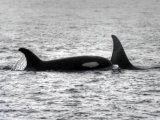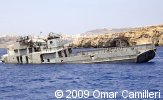Wednesday, September 23, 2009
Killer Whales Die without Chinook Salmon
 When you mention killer whales, the image of one ambushing a terrified seal often springs to mind. But there are populations of killer whales who live exclusively on fish. And not on just any fish: they are very specialised in which fish they will eat.
When you mention killer whales, the image of one ambushing a terrified seal often springs to mind. But there are populations of killer whales who live exclusively on fish. And not on just any fish: they are very specialised in which fish they will eat. According to research published in Biology Letters, two populations studied in the northeastern Pacific Ocean prefer to eat Chinook salmon (Oncorhynchus tshawytscha). So much so that if the numbers of Chinook salmon drop this directly affects the numbers of killer whales. The whales seem unable to adopt a new food, become weak and have a higher mortality.
The authors conclude that other killer whale populations may be similarly constrained to one or two prey species, because the young whales will have learnt their fishing strategies from the rest of the group. They too will be limited in their ability to switch to new food if necessary.
Journal Reference:
John K. B. Ford, Graeme M. Ellis, Peter F. Olesiuk, and Kenneth C. Balcomb
Linking killer whale survival and prey abundance: food limitation in the oceans' apex predator?
Biol Lett 2009 : rsbl.2009.0468v1-rsbl20090468.
What do you think of this news item? Join a discussion.
Labels: fish, marine biology, SCUBA News, whale and dolphins
Monday, September 21, 2009
Arctic Sea Ice Reaches 2009 Low
The Arctic sea ice cover appears to have reached its minimum extent for the year, the third-lowest recorded since satellites began measuring sea ice extent in 1979, according to the University of Colorado at Boulder's National Snow and Ice Data Center.
While this year's September minimum extent was greater than each of the past two record-setting and near-record-setting low years, it is still significantly below the long-term average and well outside the range of natural climate variability, said NSIDC Research Scientist Walt Meier. Most scientists believe the shrinking Arctic sea ice is tied to warming temperatures caused by an increase in human-produced greenhouse gases being pumped into Earth's atmosphere.
Atmospheric circulation patterns helped the Arctic sea ice spread out in August to prevent another record-setting minimum, said Meier. But most of the 2009 September Arctic sea ice is thin first- or second-year ice, rather than thicker, multi-year ice that used to dominate the region, said Meier.
The minimum 2009 sea-ice extent is still about 620,000 square miles below the average minimum extent measured between 1979 and 2000 -- an area nearly equal to the size of Alaska, said Meier. "We are still seeing a downward trend that appears to be heading toward ice-free Arctic summers," Meier said.
Further Reading:
National Snow and Ice Data Center
While this year's September minimum extent was greater than each of the past two record-setting and near-record-setting low years, it is still significantly below the long-term average and well outside the range of natural climate variability, said NSIDC Research Scientist Walt Meier. Most scientists believe the shrinking Arctic sea ice is tied to warming temperatures caused by an increase in human-produced greenhouse gases being pumped into Earth's atmosphere.
Atmospheric circulation patterns helped the Arctic sea ice spread out in August to prevent another record-setting minimum, said Meier. But most of the 2009 September Arctic sea ice is thin first- or second-year ice, rather than thicker, multi-year ice that used to dominate the region, said Meier.
The minimum 2009 sea-ice extent is still about 620,000 square miles below the average minimum extent measured between 1979 and 2000 -- an area nearly equal to the size of Alaska, said Meier. "We are still seeing a downward trend that appears to be heading toward ice-free Arctic summers," Meier said.
Further Reading:
National Snow and Ice Data Center
What do you think of this news item? Join a discussion.
Labels: environment, research, SCUBA News
Wednesday, September 16, 2009
New wreck dive off Comino, Malta
 There is a new dive waiting off the coast of Comino: former Armed Forces of Malta (AFM) Patrol Boat P31. The wreck is 52 m long and lies at 18 m.
There is a new dive waiting off the coast of Comino: former Armed Forces of Malta (AFM) Patrol Boat P31. The wreck is 52 m long and lies at 18 m.The Malta Tourism Authority co-ordinated the scuttling of the former Patrol Boat to add to the number of underwater attractions for scuba divers visiting Ċirkewwa and Comino.
The Parliamentary Secretary for Tourism, the Hon. Dr Mario de Marco said that Malta has nine wrecks being purposely scuttled vessels for diving; and that the P31's scuttling is part of a two-phase project to scuttle two patrol boats. The first was the P29 which was scuttled in Ċirkewwa in August 2007.
He also referred to the process of the scuttling which included an Environmental Impact Assessment carried out to assess the environmental impact of this project. As a result of the studies, the scuttling location was shifted by approximately 30 metres to avoid important sea grass beds.
He added that the Maltese Islands last year attracted almost 55,000 divers with the majority hailing from the UK, Germany and Italy.
Malta is renowned as a diving destination, with two of its dive sites making it into the list of the top ten European dive sites, as voted for by SCUBA Travel readers.
Further Information:
Malta Tourism Authority
AFM Video of the Scuttling
What do you think of this news item? Join a discussion.
Labels: Europe, Malta and Gozo, Mediterranean, wrecks
Friday, September 11, 2009
Rare Algae Saves Caribbean Coral
 A rare opportunity has allowed a team of scientists to evaluate corals--and the essential, photosynthetic algae that live inside their cells--before, during, and after a period in 2005 when global warming caused sea-surface temperatures in the Caribbean to rise.
A rare opportunity has allowed a team of scientists to evaluate corals--and the essential, photosynthetic algae that live inside their cells--before, during, and after a period in 2005 when global warming caused sea-surface temperatures in the Caribbean to rise.The team, led by Penn State biologist Todd LaJeunesse, found that a rare species of algae that is tolerant of stressful environmental conditions proliferated in corals at a time when more sensitive algae that usually dwell within the corals were being expelled.
Certain species of algae have evolved over millions of years to live in symbiotic relationships with species of corals. These photosynthetic algae provide the corals with nutrients and energy, while the corals provide the algae with a place to live.
"There is a fine balance between giving and taking in these symbiotic relationships," said LaJeunesse.
Symbiodinium trenchi is normally a rare species of algae in the Caribbean, according to LaJeunesse. "Because the species is apparently tolerant of high or fluctuating temperatures, it was able to take advantage of a 2005 warming event and become more prolific."
Symbiodinium trenchi appears to have saved certain colonies of coral from the damaging effects of unusually warm water.
"As ocean temperatures rise as a result of global warming, we can expect this species to become more common and persistent," said LaJeunesse. "However, since it is not normally associated with corals in the Caribbean, we don't know if its increased presence will benefit or harm corals in the long term."
If Symbiodinium trenchi takes from the corals more than it gives back, over time the corals' health will decline.
In 2005, sea surface temperatures in the Caribbean rose by up to two degrees Celsius above normal for a period of three to four months, high enough and long enough to severely stress corals.
The process of damaged or dying algae being expelled from the cells of corals is known as bleaching because it leaves behind bone-white coral skeletons that soon will die without their symbiotic partners.
Although Symbiodinium trenchi saved some corals from dying in 2005, LaJeunesse is concerned that the species might not be good for the corals if warming trends continue and Symbiodinium trenchi becomes more common.
"Because Symbiodinium trenchi does not appear to have successfully co-evolved with Caribbean coral species, it may not provide the corals with adequate nutrition," he said.
The research was published in the online version of the journal Proceedings of the Royal Society B on September 9, 2009.
What do you think of this news item? Join a discussion.
Labels: Caribbean, coral, environment, marine biology, research, SCUBA News